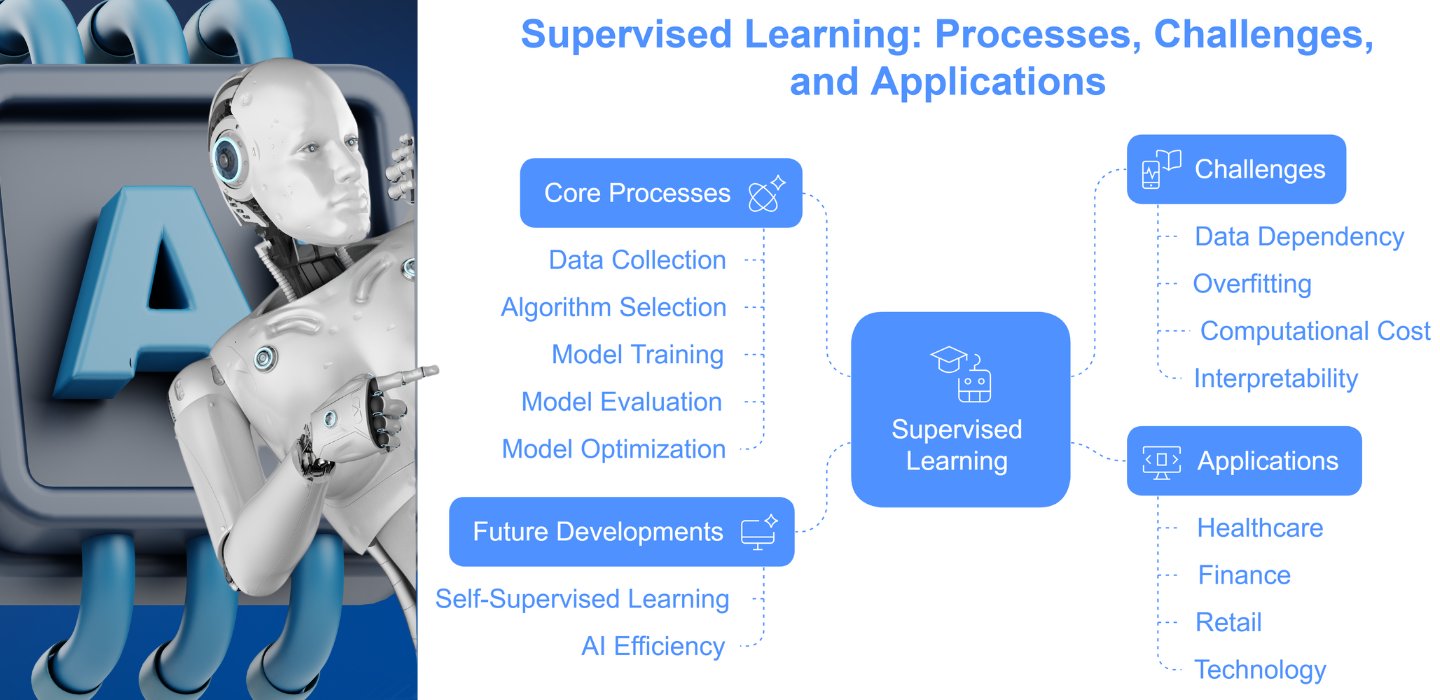Table Of Contents

Supervised Learning: The Foundation of Machine Learning and How It Works
Supervised learning is the backbone of modern machine learning. It is used in fraud detection, medical diagnostics, speech recognition, recommendation systems, and autonomous driving. Understanding it means knowing how AI models learn patterns from labeled data, optimize performance, and generalize to new inputs. Unlike traditional programming, where rules are explicitly defined, supervised learning learns from examples. It takes input-output pairs, finds relationships, and applies them to make predictions. This approach makes AI powerful, scalable, and adaptable across industries.
How Supervised Learning Works: The Core Process
The concept is simple, AI learns from labeled data. It maps inputs (features) to outputs (labels) using mathematical models. The goal is to minimize errors and make accurate predictions on unseen data.
Step One: Data Collection and Labeling
The first step is gathering a dataset where each input has a corresponding correct output. This labeled data acts as a reference for the model.
Examples
- Email Classification Emails labeled as spam or not spam
- Medical Diagnosis X-ray images labeled as cancerous or non-cancerous
- Stock Price Prediction Historical stock data with actual price movements
The quality of data determines how well the model performs. Garbage in, garbage out. Poorly labeled or biased data leads to unreliable AI.
Step Two: Choosing the Right Algorithm
Once data is prepared, the next step is selecting the right supervised learning algorithm. The choice depends on the type of prediction
- Classification Used when the output belongs to a category, e.g. spam vs. not spam
- Algorithms Logistic Regression, Decision Trees, Random Forest, Support Vector Machines SVM, Neural Networks
- Regression is used when the output is a continuous value e.g., predicting house prices
- Algorithms Linear Regression, Polynomial Regression, Ridge Regression, Neural Networks
Each algorithm has strengths and weaknesses. Simple models like linear regression are interpretable but may not capture complex patterns. Complex models like deep learning are powerful but require more data and computation.
Step Three: Training the Model
The AI model learns by analyzing patterns in the training data. It does this by adjusting its internal parameters, weights and biases to minimize errors. The process involves
- Forward Propagation The model makes an initial prediction
- Loss Calculation It compares the prediction with the actual output using a loss function
- Backward Propagation The model adjusts its parameters using gradient descent to reduce the error
This loop repeats thousands or millions of times until the model learns to generalize well to new data.
Step Four: Model Evaluation and Testing
Once trained, the model is tested on unseen data to evaluate its performance. Metrics like accuracy, precision, recall, F1-score for classification, and RMSE for regression measure how well it performs.
A well-trained model should generalize to real-world scenarios and not just memorize the training data. Overfitting happens when the model learns patterns too specific to the training data, making it fail on new inputs.
Step Five: Model Optimization and Deployment
If the model underperforms, optimization techniques like hyperparameter tuning, cross-validation, and feature engineering improve results. Once optimized, it is deployed into applications like chatbots, recommendation systems, fraud detection engines, and self-driving cars.
Why Supervised Learning Works So Well
Supervised learning is effective because
- It learns from real-world data, unlike rule-based systems, it does not require manually coded instructions
- It generalizes well. A properly trained model can make accurate predictions on new, unseen data
- It is scalable. Once trained, it can process millions of data points instantly
- It powers most AI applications from voice assistants to medical diagnostics, supervised learning is everywhere
Challenges in Supervised Learning and How Experts Overcome Them
Data Dependency
Supervised learning requires a large amount of labeled data. If data is limited or biased, the model struggles to generalize.
Solution Use data augmentation, transfer learning, and synthetic data generation to improve performance.
Overfitting
A model that memorizes training data but fails on new data is useless.
Solution Use regularization techniques, dropout layers, and cross-validation to prevent overfitting.
Computational Cost
Training deep learning models with large datasets requires high computational power.
Solution Use cloud computing, distributed training, and optimized hardware GPUs, TPUs to speed up training.
Interpretability
Some supervised learning models, especially deep learning, act as black boxes. It is hard to understand why they make certain decisions.
Solution Use Explainable AI XAI techniques like SHAP, LIME, and feature importance analysis to make models transparent.
Real-World Applications of Supervised Learning
Supervised learning is widely used in industries like
- Healthcare Disease detection, patient risk analysis, medical image classification
- Finance Fraud detection, credit scoring, stock market prediction
- Retail Customer segmentation, demand forecasting, personalized recommendations
- Technology Speech recognition, facial recognition, AI-driven chatbots
Every time Netflix recommends a movie, Siri understands a command, or an email is filtered as spam, supervised learning is at work.
The Future of Supervised Learning
The field is evolving. Self-supervised learning is reducing the need for labeled data by allowing models to learn from unlabeled datasets. AI is becoming more efficient, scalable, and accessible, enabling breakthroughs in automation, robotics, and decision-making.
Supervised learning remains the foundation of AI systems, powering everything from voice assistants to self-driving cars. Engineers who master it will continue leading innovation in AI-driven technology.











